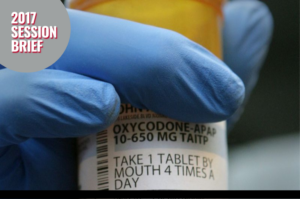By John Slights and Brittany Jefferson
 Ohio, West Virginia, and Utah. When we talk about the opioid epidemic, it’s usually about these states, which have been the hardest hit by heroin and prescription drug abuse and overdoses. Thus far, the state of Georgia has not been a part of the conversation, but it may be soon.
Ohio, West Virginia, and Utah. When we talk about the opioid epidemic, it’s usually about these states, which have been the hardest hit by heroin and prescription drug abuse and overdoses. Thus far, the state of Georgia has not been a part of the conversation, but it may be soon.
“Georgia is number 11 in the country for heroin deaths per capita,” said Amanda Abraham, an assistant professor of public administration and policy at the University of Georgia. “We are what’s known as a second-tier state – we aren’t the worst of the worst when it comes to this epidemic, but we’re quickly rising and we’re not far removed from it at all. There is reason to be alarmed.”
Abraham was one of three panelists who spoke to Georgia’s growing opioid crisis at the State of the Public’s Health Conference in Athens, Georgia, on October 17th. The panel, which included Substance Abuse Research Alliance (SARA) director Jim Langford and Lawrence Bryant with the Georgia Department of Public Health, outlined the latest data on opioid abuse as reported in SARA’s recent white paper.
“In the United States, you can get heroin in almost 10 to 15 minutes upon arriving in any town,” said Langford. “What makes this drug so dangerous is how easy it is to obtain.”
In 2016, there were 50,018 heroin-related deaths in the United States, but “the CDC estimates that number could be 40 percent higher, since a lot of heroin deaths remain unreported or are the result of a health condition related to the drug’s abuse,” Langford said.
Abraham added that 68.8 percent of all drug-related deaths in the state of Georgia for 2017 are estimated to be related to opioids or heroin.
“The main issue is that a lot of these deaths are taking place in rural areas,” Abraham said. “People lack access to the proper resources for treatment and don’t have access to proper medical care, which is why we are seeing so many heroin-related deaths in these parts of the state.”
The white paper outlined eight strategies state legislators should consider in developing drug abuse prevention policy.
“We have to work together and collaborate,” Bryant said, who also offered an update on DPH’s simultaneous efforts to tackle the epidemic. “It’s going to take a team effort from public health officials and the public.”
Bryant advocated for increasing funding for treatment for heroin addicts in the state, as well as increasing access to treatment, largely for those addicted living in rural areas.
“We need to work together to change the culture for addicts, from one of shaming addicts to having compassion for addicts. We must change the rhetoric.”
Bryant knows first-hand about the dark side of drug addiction and the salvation of rehabilitation. He was once addict himself before receiving treatment for substance abuse and turning his life around.
“Often times when we’re doing our work, we don’t always hear the stories of the people that were impacted,” he said. “On August 26, I celebrated 26 years of continuous sobriety. Once the work that we are doing can be implemented, people’s lives can be changed.”
SARA’s finalized white paper, which will provide a framework for legislators to enact the appropriate changes to decrease overdoses and improve access to treatment, will be available at the end of the year. The Georgia Department of Public Health’s fully-developed proposal to combat the heroin epidemic will be unveiled in early February of next year.
